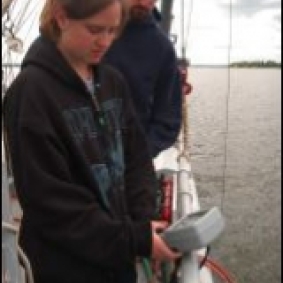Eight students will be presenting the summer work at the Ocean Sciences Meeting in March 2022!
Kahla Elliston, Texas A&M University, Corpus Christi
Class Year:
2005Mentor:
Judy O'Neil, Ph.D.Project Title:
Nitrogen Fixation in Various Estuarine Environments of Chesapeake Bay
Abstract:
Nitrogen is considered to be the most common nutrient limiting primary production and growth in the oceans (Capone, 2001; Blackburn and Sorensen, 1988). Nitrogen fixation was studied in the rinsed roots, rhizomes, and blades with associated sediment of several bay grasses including Vallisnaria americana, Potamogeton perfoliatus, Hydrilla verticillata. Nitrogen fixation was also studied in pelagic areas containing cyanobacterial blooms, and sediment loaded with different organic treatments in mesocosms. Nitrogen fixation was determined using the Acetylene Reduction Assay and detected using a flame ionization detector, Gas Chromatograph. Organic content seemed to play the major factor influencing nitrogen fixation in sediment. The mesocosms that contained different organic treatments had higher rates of nitrogenase activity in the higher percentages of organic treatments. Bay grass roots, Myriophyllum sp. yielded higher rates of nitrogenase activity. Rates of nitrogenase acitivity in the pelagic realm was higher in the cyanobacterial bloom rather than outside of the bloom. Overall in the Chesapeake Bay nitrogen fixation was ubiquitous, variable, and relatively high in localized areas and maybe a source of "new" nitrogen.
Location:
Horn Point LaboratoryPublications:
Wicks, E. C., E. W. Koch, J. M. O'Neil, and K. Elliston*. 2009. Effects of sediment organic content and hydrodynamic conditions on the growth and distribution of Zostera marina . Marine Ecology Progress Series 378:71-80 .





